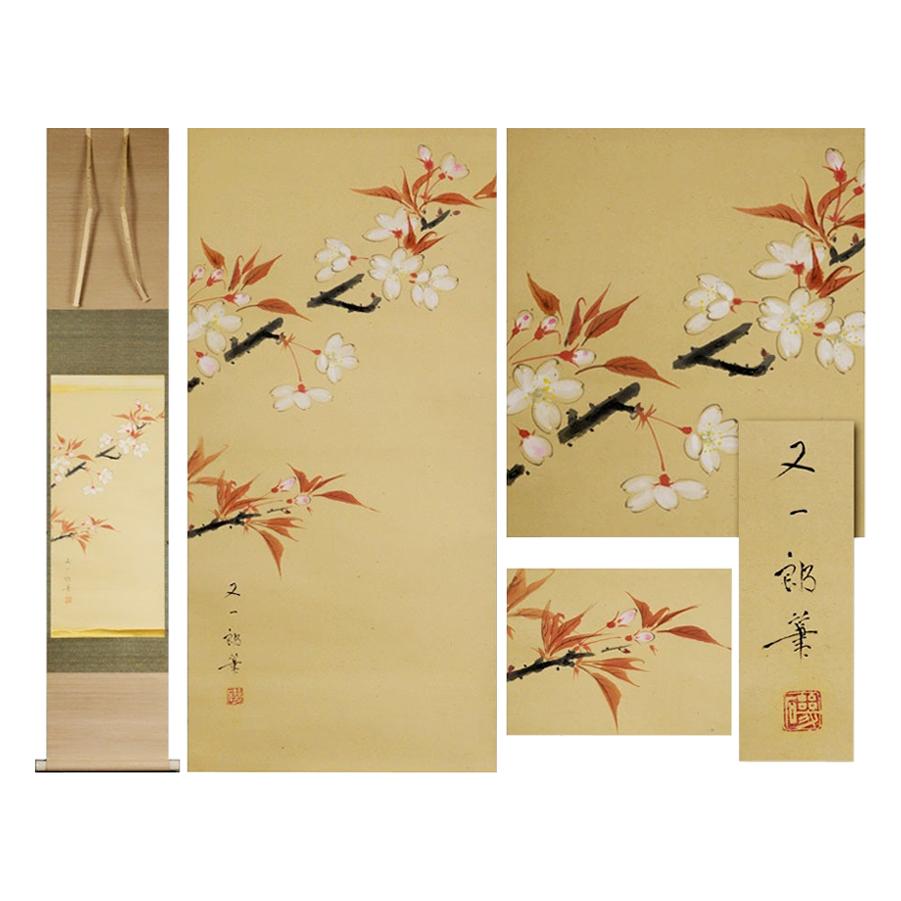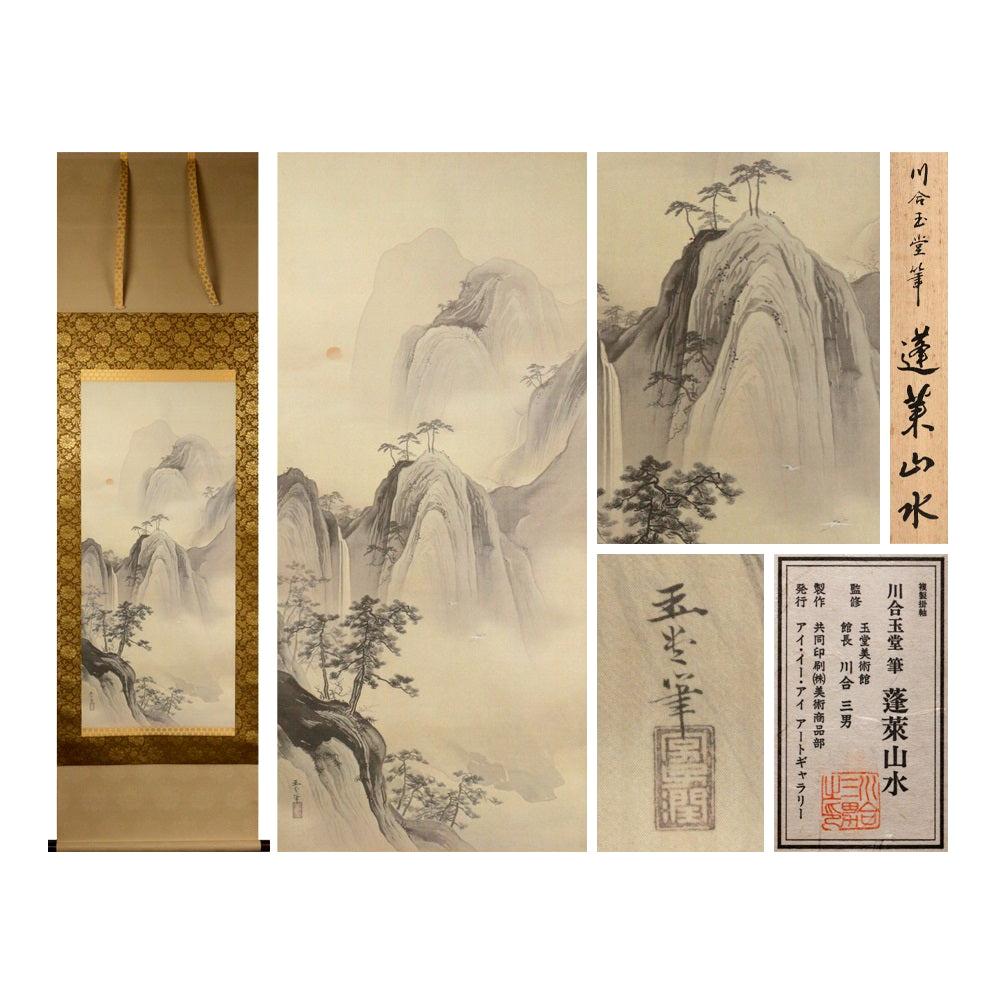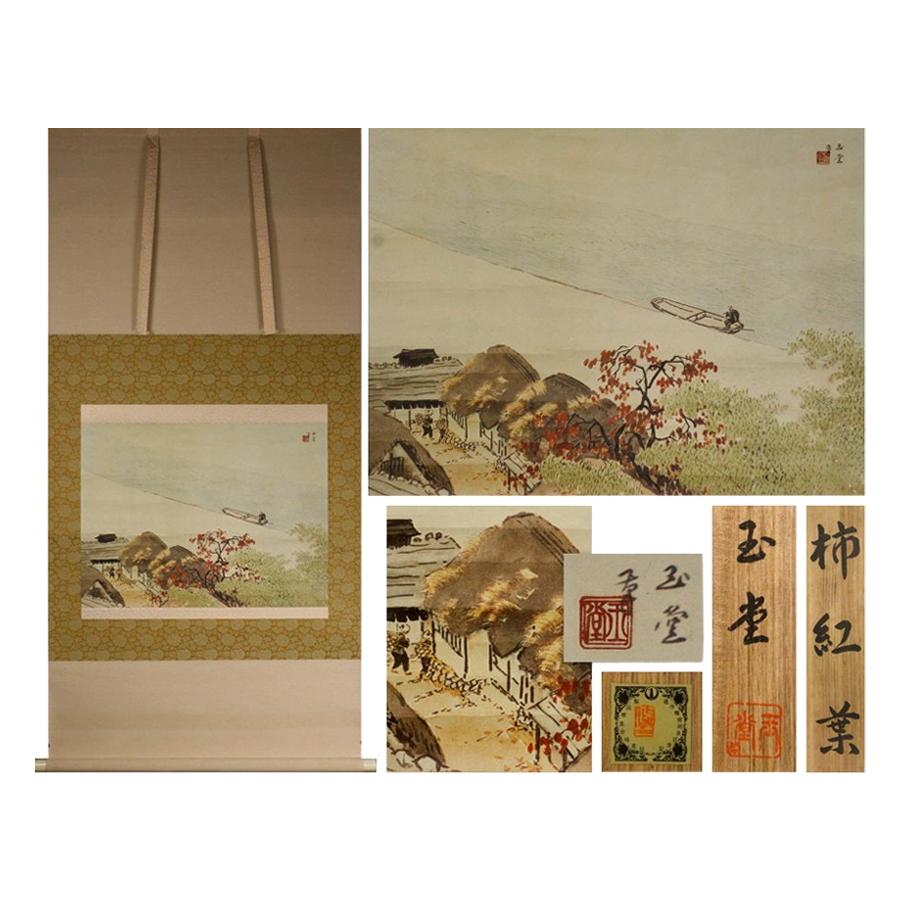Items Similar to Mountain Scene Showa Period Scroll Japan 20c Artist Kazuhide Saiuchi Nihonga St
Want more images or videos?
Request additional images or videos from the seller
1 of 6
Mountain Scene Showa Period Scroll Japan 20c Artist Kazuhide Saiuchi Nihonga St
About the Item
As you can see, this work was drawn by Kazuhide Sainai, who is known as a Japanese-style painter.
The "Horaiyama-zu" is a very tasty view of trees, rocks, and mountains in the distance. In addition, it is a work that creates a mysterious atmosphere such as colorful houses and flying birds.
«Kazuhide Saiuchi»
Born in Tokyo in 1897, Shunkyo Yamamoto.
¦ Silk book / handwriting.
¦ There are discoloration and stains in the state era.
¦ Shaft dimensions / approx. 140.0 cm x approx. 65.0 cm.
¦ Paper dimensions / approx. 43.5 cm x approx. 49.5 cm.
¦ Signs / There are inscriptions and seals as you can see.
¦ Box / common box.
- Dimensions:Height: 55.12 in (140 cm)Width: 25.6 in (65 cm)Depth: 0.04 in (1 mm)
- Style:Showa (Of the Period)
- Materials and Techniques:
- Place of Origin:
- Period:
- Date of Manufacture:20th Century
- Condition:Wear consistent with age and use. Silk book / handwriting. ■ There are discoloration and stains in the state era. ■ Shaft dimensions / approx. 140.0 cm x approx. 65.0 cm. ■ Paper dimensions / approx. 43.5 cm x approx. 49.5 cm. ■ Signs / There are inscriptions and seals as you can.
- Seller Location:Amsterdam, NL
- Reference Number:
About the Seller
5.0
Gold Seller
These expertly vetted sellers are highly rated and consistently exceed customer expectations.
Established in 2015
1stDibs seller since 2019
158 sales on 1stDibs
Typical response time: 9 hours
- ShippingRetrieving quote...Ships From: Amsterdam, Netherlands
- Return PolicyA return for this item may be initiated within 14 days of delivery.
More From This SellerView All
- Mountain Scene Showa Period Scroll Japan 20c Artist Kohiro Sato Nihonga StyleLocated in Amsterdam, Noord HollandAs you can see, it is a work drawn by Kohiro Sato. It is a simple but unique presence of a river boat, and it is a very tasty work combined with the scenery reflected on the surface ...Category
20th Century Japanese Showa Paintings and Screens
MaterialsSilk
- Artists Norikuni Kawamura, Showa Period Scroll Japan 20c Artist NihongaLocated in Amsterdam, Noord HollandAs you can see, it is a double box and a box with "Shokakuzu" written by Norikuni Kawamura. The "Shokaku-zu", which is composed of graceful textures, spreads its wings and flies, i...Category
20th Century Japanese Showa Paintings and Screens
MaterialsSilk
- Cherry Blossoms Showa Period Scroll Japan 20c Artist Mataichiro Isoda Nihonga stLocated in Amsterdam, Noord HollandName Kakejiku Calligraphy Kikuzu Paper Book Coloring Inscription (Shizushiro) Size Axis: 195 cm in length, 42.5 cm in width, 131.5 cm in length, 31.5 cm in width * Status I don't k...Category
20th Century Japanese Showa Paintings and Screens
MaterialsSilk
- Cherry Blossoms Showa Period Scroll Japan 20c Artist Mataichiro Isoda Nihonga StLocated in Amsterdam, Noord HollandBorn in Kyoto, Isoda Mataichirô studied painting at the Kyoto City Specialist School of Painting. After graduating there he studied Japanese-style painting with Kikuchi Keigetsu. Though primarily a painter he also made a number of woodblock designs for Unsôdô in Kyoto. is a very beautiful work in which the cherry blossoms in full bloom are drawn by the master, Mataichiro Isoda . "Mataichiro Isoda" Japanese-style painter. Born in Kyoto. Graduated from Kyoto City University of Arts, Department of Painting in 1914, and Kyoto City University of Arts in 1933 . Advance to the graduate school and complete. He studied under Keigetsu Kikuchi and was selected for the first time in the 8th Imperial Exhibition in 1945 with "Yin". Since then, he has been selected for the Imperial Exhibition, the Reorganized Imperial Exhibition, and the Nitten Exhibition almost every time. After the war, he was selected from the 3rd Nitten Exhibition in 1947, and "Chatei Liqiu" was selected at the 5th Exhibition in 1945. Since then, he will win an exhibition prize every time. 1956 Participated in the formation of Shirakosha by Uda Tekison, and exhibited at regular exhibitions until 1966 . Nitten party friend. During this time, he was a professor at Kacho Girls' High School from 28 to 1955. e specializes in flower and bird...Category
20th Century Japanese Showa Paintings and Screens
MaterialsSilk
- Artists Kawai Gyokudō Showa Period Scroll Japan 20c Artist NihongaLocated in Amsterdam, Noord HollandKawai Gyokudo (?? ??, November 24, 1873-June 30, 1957) was the pseudonym of a Japanese painter in the Nihongo school, active from Meiji through Showa period Japan. His real name was Kawai Yoshisaburo. Contents Biography Gyokudo was born in what is now Ichinomiya city, Aichi Prefecture, as the eldest son of a paper, ink and brush merchant. He went to Kyoto in 1887 to study under Kono Bairei of the Maruyama-Shijo school of painting. In 1896, he moved to Tokyo and he became the student of Hashimoto Gaho, of the Kano school. He also studied Western-style painting and developed a highly personal style, especially in the field of landscape painting. Gyokudo is noted for his polychrome and occasionally monochrome works depicting the mountains and rivers of Japan in the four seasons, with humans and animals shown as part of the natural landscape. Among his representative works are Futsuka zuki (“The New Moon”), Yuku haru (“The Departing Spring”), Mine-no-yu (“Evening at the Mountain Top”), and Bosetsu (“Snow in the Evening”). In 1898, Gyokudo joined with Okakura Tenshin and Yokoyama Taikan...Category
20th Century Japanese Taisho Paintings and Screens
MaterialsSilk
- Artists Kawai Gyokudō Showa Period Scroll Japan 20c Artist NihongaLocated in Amsterdam, Noord HollandKawai Gyokudo (?? ??, November 24, 1873-June 30, 1957) was the pseudonym of a Japanese painter in the Nihongo school, active from Meiji through Showa period Japan. His real name was Kawai Yoshisaburo. Contents Biography Gyokudo was born in what is now Ichinomiya city, Aichi Prefecture, as the eldest son of a paper, ink and brush merchant. He went to Kyoto in 1887 to study under Kono Bairei of the Maruyama-Shijo school of painting. In 1896, he moved to Tokyo and he became the student of Hashimoto Gaho, of the Kano school. He also studied Western-style painting and developed a highly personal style, especially in the field of landscape painting. Gyokudo is noted for his polychrome and occasionally monochrome works depicting the mountains and rivers of Japan in the four seasons, with humans and animals shown as part of the natural landscape. Among his representative works are Futsuka zuki (“The New Moon”), Yuku haru (“The Departing Spring”), Mine-no-yu (“Evening at the Mountain Top”), and Bosetsu (“Snow in the Evening”). In 1898, Gyokudo joined with Okakura Tenshin and Yokoyama Taikan...Category
20th Century Japanese Taisho Paintings and Screens
MaterialsSilk
You May Also Like
- Japanese Showa Period Peacocks Painted on SilkLocated in Rio Vista, CAColorful Japanese ink and color on silk Showa painting of a pair of peacocks. Vivid colors and beautiful details with a signature and seal on right side bottom. Framed in a midcentur...Category
20th Century Japanese Showa Paintings and Screens
MaterialsSilk, Plexiglass, Paper, Wood
- Japanese Showa Period Folding Screen with Painted CranesLocated in New York, NYJapanese Showa period four panel folding screen finely painted with a theme of cranes in four elegant positions. The piece is signed and was made in circa 1950 in Japan. In great vi...Category
Vintage 1950s Japanese Showa Paintings and Screens
MaterialsFabric, Wood, Paint
- Japanese Style Showa Six Panel Screen Chinese Gilt Mountain LandscapeLocated in Rio Vista, CAImpressive Japanese style Showa period six-panel byobu screen featuring a serene Chinese mountain landscape along a waterway over a dramatic gilt background. The painting is accompan...Category
20th Century Asian Showa Paintings and Screens
MaterialsWood, Paper
- Japanese Showa Period Mounted Screen Manchurian Cranes with PinesLocated in Rio Vista, CAImposing Japanese Showa period two panel byobu screen later mounted in a large gilt and ebonized wood frame. The screen depicts a pair of large redheaded Manchurian cranes flying ami...Category
20th Century Japanese Showa Paintings and Screens
MaterialsSilk, Wood
- Japanese Four-Panel Folding Screen Byobu Signed Showa Period C.1950Located in London, GBA four-panel Japanese Byobu folding screen depicting a floral scene with birds. Japan, C.1950 Showa Period An attractive example, beautifully h...Category
Mid-20th Century Japanese Showa Paintings and Screens
MaterialsSilk, Paper
- Japan Scroll Painting, Meiji PeriodLocated in Pasadena, CAThis is a wonderful example of a Meiji Period screen painting of Japanese Tanuki or racoon dogs in a landscape. The Tanuki is considered to be a mythical creature Japanese culture. T...Category
Antique Late 19th Century Japanese Meiji Paintings and Screens
MaterialsFabric, Paint
Recently Viewed
View AllMore Ways To Browse
Yamamoto Shunkyo
Japanese Scroll Painting Signed
Beige Mountain Paintings
Showa Silk Paintings
Asian Artist Painting
Chinoiserie Fabric Panels
Antique Korean Panel
Japanese Screen Four Seasons
Soapstone Pagoda
Large Painting Water Asian
Japanese Art Brocade Panels Frame
Art Silk
Mineral Pigment
Ge Ba Textiles
Joseon Portrait
Kindrie Grove
Mori Tetsuzan
Chen Hongshou





